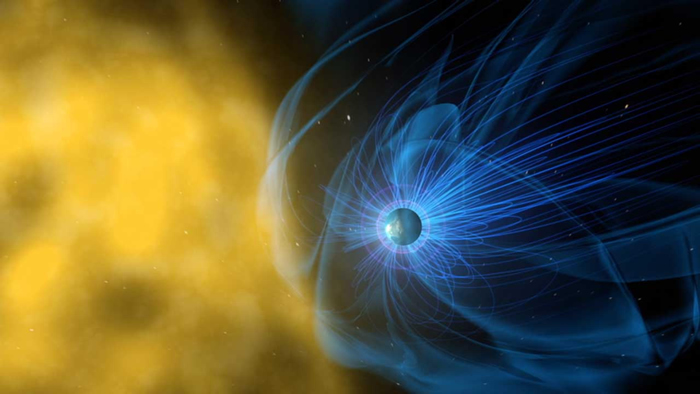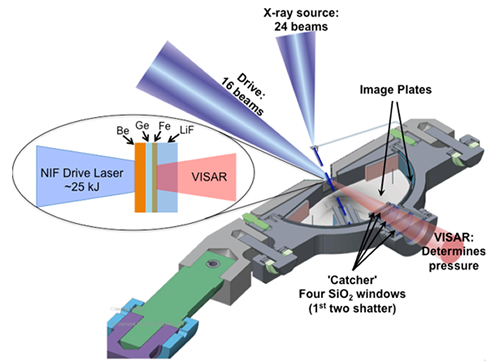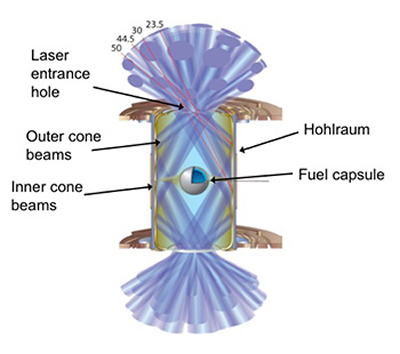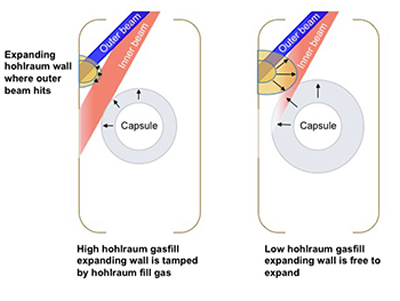Experimental Highlights - 2017
May
Ignition: Improving Efficiency with Low-Fill Hohlraums
Probing the Possibility of Life on ‘Super-Earths’
Along with its aesthetic function of helping create the glorious Arora Borealis, or Northern Lights, the powerful magnetic field surrounding our planet has a fairly important practical value as well: it makes life possible.
By deflecting harmful charged particles from the sun and the cosmic rays that constantly bombard the planet, and preventing the solar wind from eroding the atmosphere, Earth’s magnetic field has allowed multi-cellular life forms up to and including humans to develop and survive.
 Earth is surrounded by a giant magnetic bubble called the magnetosphere, which is part of a dynamic, interconnected system that responds to solar, planetary, and interstellar conditions. Credit: NASA
Earth is surrounded by a giant magnetic bubble called the magnetosphere, which is part of a dynamic, interconnected system that responds to solar, planetary, and interstellar conditions. Credit: NASA And now, with the discovery of thousands of planets beyond the Solar System known as exoplanets, scientists are eager to learn if rocky “super-Earths,” up to ten times more massive than Earth, might also be able to harbor life.
“Finding habitable exoplanets is one of the top three goals of the planetary science and astronomy communities,” said LLNL physicist Rick Kraus. “With these discoveries come many questions: What do these planets look like? Is our solar system unique? Is Earth unique? Or more specifically, is Earth uniquely habitable?”
Those questions have inspired a current NIF Discovery Science campaign aimed at determining if giant rocky planets could have Earth-like magnetic fields. An atmosphere, mild climate, and liquid water are usually considered the bare essentials for life as we know it to evolve, but the presence of a magnetic field is equally important, Kraus said. “Active plate tectonics and a magnetosphere are both considered requirements for a habitable exoplanet,” he said. “A stable surface environment free of ionizing radiation is one of the most important qualities of a planet that are considered a requirement for habitability.”
This video shows an artist’s impression of the super-Earth 55 Cancri e moving in front of its parent star. Nearly twice the size of Earth, the exoplanet is relatively close to Earth at 40 light-years away. During these transits astronomers were able to retrieve the planet’s spectrum embedded in the light of its parent star. The analysis showed that the atmosphere of 55 Cancri e consists mainly of helium and hydrogen with hints of hydrogen cyanide. Credit: ESA/Hubble, M. KornmesserEarth’s magnetic field is generated as convection currents in the planet’s liquid iron outer core are twisted by the planet’s spin, creating a magneto-dynamo that produces the magnetosphere (dynamos convert mechanical energy into electric energy or in this case, magnetism). A planet with only a solid core may not have a magnetic field, and thus be unlikely to harbor life as we know it. “We need to understand the melting transition of the iron cores in order to determine if it is even possible to have a liquid outer core and a solid inner core within a super-Earth,” Kraus said.
Melting Curve is Critical
“The interior pressures of super-Earths are so extreme, up to 35 million times (Earth’s) atmospheric pressure, that we have very little information about how materials might actually behave within them,” he added. “The melting curve of iron is critical to addressing the question of whether a super-Earth could have a protective magnetosphere. It is the pressure-induced solidification of iron which releases the latent heat that drives the complex convective flow within a planet’s core.”
The research team is using a NIF experimental platform called TARDIS (target diffraction in situ) to study the melting curve of iron at pressures ranging from five to 20 megabar (five to 20 million Earth atmospheres). The TARDIS x-ray diffraction diagnostic is designed to shed light on the phase changes, or structural transitions between states of matter, that occur in materials under such extreme pressures and temperatures (see “NIF’s TARDIS Aims to Conquer Time and Space”).

The campaign builds on a novel experimental technique developed at the Omega Laser Facility at the University of Rochester. The researchers shock an iron sample so it liquefies at 2.5 Mbar and then use ramp (shockless) compression to compress it to 10 Mbar. In situ x-ray diffraction, currently the most accepted means for measuring melting and solidification, is used to confirm that the first shock melted the material and the subsequent ramp-compression wave caused it to re-solidify (unlike shock compression, ramp compression keeps sample temperatures low and allows the study of matter compressed to extreme densities).
“The experiments also represent a significant advance over what can be explored about the melting of iron using static compression experiments,” notes the campaign’s principal investigator, Russell Hemley of the George Washington University, director of the Capital/DOE Alliance Center (CDAC). “Those experiments to date have been limited to pressures of about three Mbar—or the pressures of Earth’s core—and have been controversial. Hence the new results will also improve our understanding of the core of our own planet as well as provide crucial information about the nature of super-Earths and their potential habitability.“
“One way to think about this experiment,” Kraus said, “is that we use the shockwave to create a warm dense thermal state in the iron similar to that within the liquid iron outer core of a super-Earth. Then, by subsequently shocklessly compressing the iron we simulate the thermodynamic path that would be experienced by a parcel of iron convecting deep within the liquid core of a super-Earth. With x-ray diffraction we can directly answer the question of whether that parcel of iron would solidify as it reaches a prescribed depth.”
NIF is the only facility capable of achieving and probing these extreme states of matter. The experiments require the high and sustained energy intensity only achievable on NIF, and the laser’s unique pulse-shaping capability enables ramp compression of iron from 5 to 20 Mbar. The campaign was awarded six shot days in fiscal years 2016 to 2018, enough for 12 experiments.
“If we observe solidification—diffraction from solidified iron—on the much shorter timescale of a laser experiment,” Kraus said, “then we know the melting curve is steep enough to have a solid inner core and liquid outer core, which could enable a magneto-dynamo within super-Earths. Then, our goal is to explore the different entropy states, or temperature profiles, that can be achieved in the cores of super-Earths and probe the thermodynamic path taken by a descending liquid iron parcel. This discovery would be a critical step forward in determining the types of extra-solar planets that could be habitable.”
Leading the campaign along with Kraus and Hemley are Ronald Cohen of the Carnegie Institution of Washington, Sarah Stewart of UC Davis, and Jon Eggert and Dayne Fratanduono of LLNL. Other LLNL participants in the experiments and analysis are Marius Millot, Federica Coppari, Jim Mcnaney, Amy Jenei, Chris Wehrenberg, Damian Swift, Jon Belof, Lorin Benedict, and Sebastien Hamel.
NIF experiments support the National Nuclear Security Administration (NNSA)’s Stockpile Stewardship Program to ensure the safety, security and reliability of the nation’s nuclear deterrent, while also providing scientists from around the world with unique conditions of temperature and pressure for fundamental science studies. CDAC is supported by NNSA’s Stewardship Science Academic Alliance Program.
Ignition: Improving Efficiency with Low-Fill Hohlraums
Third in a series of articles exploring the progress and challenges of LLNL’s Inertial Confinement Fusion (ICF) Program.
Article 2—“Taming Symmetry With the 2Shock”
During a National Ignition Facility experiment, or “shot,” NIF’s 192 laser beams inject millions of joules of laser energy into a small eraser-sized cylindrical gold-lined container called a hohlraum which contains a fusion target capsule at its center.
Controlling what happens inside this hohlraum is an important step on the path to generating fusion ignition and gain in the laboratory, and an LLNL team is focused on just that.

When the laser beams enter the hohlraum and strike its walls, the laser energy rapidly turns the hohlraum into an x-ray oven. These x rays bathe the target, causing the capsule shell to vaporize and drive the fuel inward at nearly 400 kilometers a second, with the goal of getting the center of the implosion to reach temperatures of more than 100 million degrees Celsius and pressures that exceed 100 billion times Earth’s atmosphere.
In order to drive the implosion symmetrically, the placement of and relative energies in the inner and outer cone laser beams have to be carefully balanced. This is complicated, however, by the fact that as the lasers hit the inside wall of the hohlraum, the walls turn into an expanding plasma, impeding the laser beam path and adversely affecting the x-ray drive symmetry—a necessary condition for ignition.
To combat this plasma, experiments during the 2006-2012 National Ignition Campaign (NIC) and the current “high-foot” campaign used hohlraums with a high helium gas fill to hold back this plasma expansion. While the high-foot experiments were the first to achieve fuel gain and alpha heating, they also showed that the high-gas-fill approach was compromised by high levels of laser plasma instabilities (LPI) that steal usable laser energy and cause drive asymmetries.
This led the program to pursue an alternate approach using hohlraums with a low gas fill to lower the LPI. The results have been promising—significantly reduced LPI, 20 to 25 percent efficiency improvement in the conversion from laser energy to x rays, and a much closer match between models and experimental results.

Low-fill hohlraums come with their own set of challenges—primarily, expansion of the hohlraum walls is less restricted by the gas fill. To combat this, the program decided to shorten the laser pulse, shaving it to 6 to 7 nanoseconds, less than half the length of pulses used in the high-foot campaign.
A change in capsule material is one way to move to shorter pulses. This approach uses targets made from high density carbon (HDC), or diamond, which has a density three times that of the plastic used in previous campaigns. This results in a much thinner capsule shell, important because pulse length is primarily determined by the time it takes for the first shock wave to travel through the capsule.
“It’s a race against time,” said Sebastian Le Pape, experimental lead for the HDC campaign. “At some point, your hohlraum is going to fill with gold, but if you can drive your implosion with short enough laser pulses before it closes, you’ll be fine. That’s what HDC allows you to do, and the advantage of low gas fill means that you don’t have LPI and aren’t using energy to heat up the gas. This combination is a more efficient platform.”
A perennial concern for ignition is implosion symmetry—absolutely critical for ignition. The combination of low-fill hohlraums and HDC is paying dividends in this area. “Based on the measurement techniques that we have, we believe that these implosions are driven pretty symmetrically through the entire pulse,” said Debbie Callahan, associate division leader for ICF in LLNL’s Design Physics division, and deputy program lead for Integrated Experiments.

“A long-term concern, even prior to the NIC, was that it would be impossible to control the symmetry in the hohlraum,” Callahan said. “Symmetry is a big challenge, and it’s a major accomplishment that we’ve been able to do that.”
In addition, a more symmetric implosion is more efficient, and that is showing in the yield. “While our total yield hasn’t gone up, our yield per unit laser energy has,” Callahan noted. “We’re getting the same yield, but with less laser energy. What that says is that we’ve improved the quality of the implosion, converting the energy into yield in a more efficient way.”
Now that the implosions are driven more symmetrically, the team has been able to get a clearer look at engineering features that impact the implosion, such as the fill tube used to fill the capsule with deuterium-tritium fuel and the capsule support that holds the capsule in place in the hohlraum. The program is now working on reducing the impact of those components, and this will be explored in a future article in this series.
Looking ahead, the program now plans to focus on applying what has been learned to further improve target designs.
“We’ve progressed an amazing amount, building on the original NIC efforts,” said Laura Berzak Hopkins, design lead for the HDC Campaign. “We’ve been able to nearly remove backscatter as a source of energy loss and potential laser damage. We’ve been able to work with platforms where the code is more predictive of drive and where the hohlraum reaches higher temperatures with the same amount of laser energy.
“And in the past year,” she said, “we’ve been able to predictably design and measure implosions in which we can control symmetry much better. What we hope to do now is to use what we’ve learned to try to make further improvements to target performance.”




